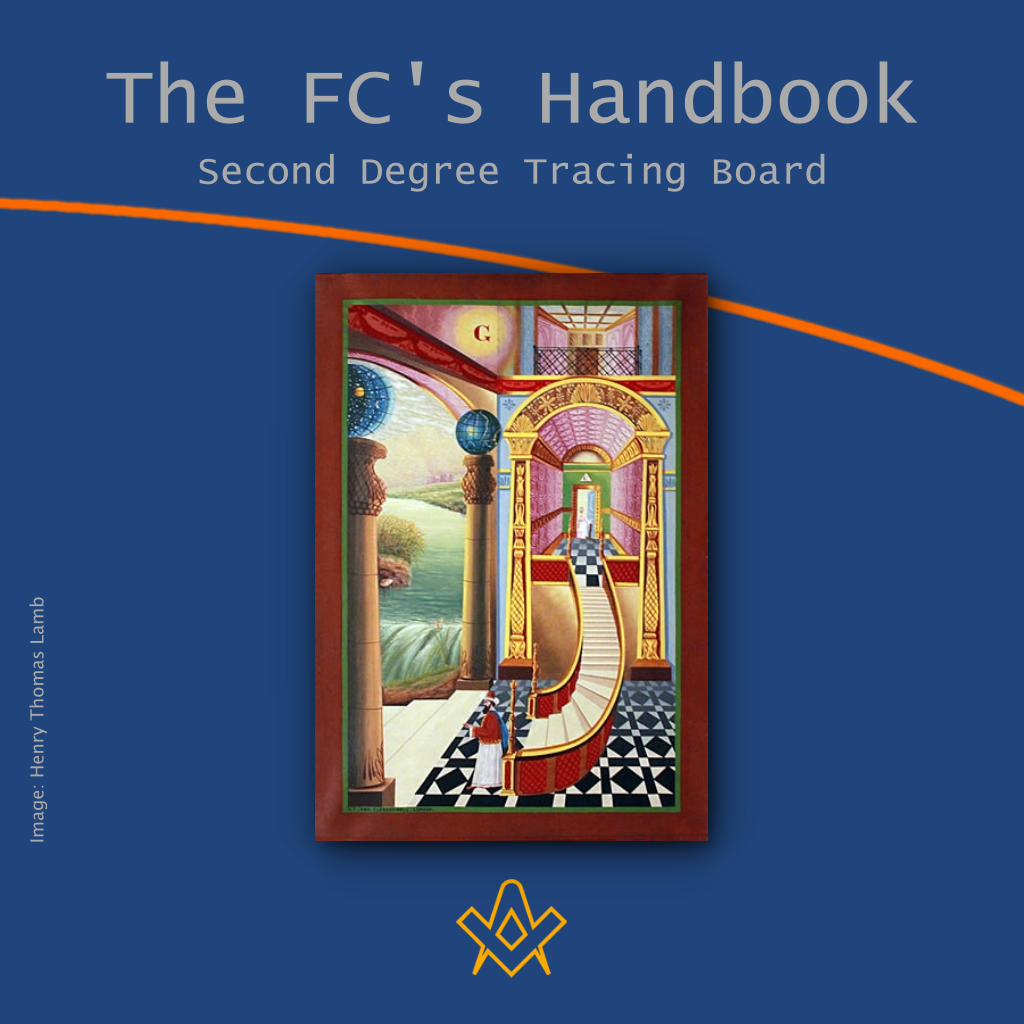The main teaching of the second degree is contained in the picture of the tracing board, and with regard to at any rate some of the incidents and facts an allegorical meaning is evident.
The first important architectural feature mentioned is a pair of columns, stated to have been set up at the porchway or entrance of the Temple.
CHAPTER V – Second Degree Tracing Board
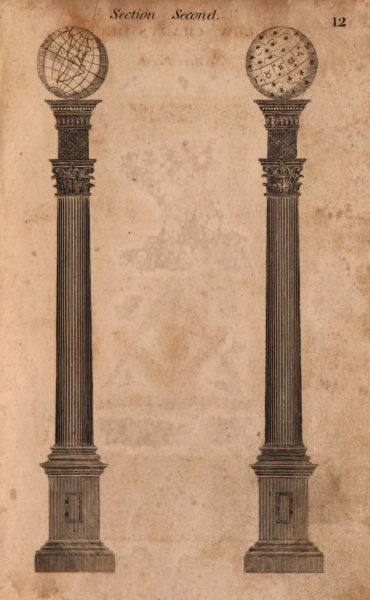
two pillars
IMAGE LINKED: wikimedia Attribution 4.0 International (CC BY 4.0)
These pillars seem always to have had a peculiar fascination for our masonic ancestors, and even in the early days of the Comacines we find them setting up B**Z and J****N in the porch of the mediaeval church at Wurzburg, but their symbolical history runs back very much further even than the days of King Solomon’s Temple.
The two pillars Tat and Tattu are found in the early papyri of the Book of the Dead in Egypt [*Ed. see note below], and appear to have had the meaning of “in strength” and ” to establish firmly,” but even in the primitive initiation rites of the Yaos, in Nyasaland, the boys, after various adventures, have to pass between two pillars.
The original meaning of these pillars was undoubtedly phallic, and in rites dealing with whence we come are obviously appropriate.
The use of the word ‘S’ in a ceremony which, like these Yao rites, aims at increasing the procreative powers of the members of the tribe by a magical ritual, is obvious, but at a later date more ethical meanings were naturally grafted on to the basic one.
That this original idea was not forgotten when the twin columns were set up by King Solomon is clear from the description of the chapiters.
The net work, denoting union, combined with the my work, denoting virginity, and the subsequent references to the pomegranates with their abundant seeds, convey the same lesson, as do certain other adornments of the columns, but already other more evolved ideas had been grafted on to the age-old symbols.
Thus, the fact that they were formed hollow in order to serve as archives for Freemasonry, for therein were deposited, etc., seems to refer to the doctrine of re-incarnation.
The constitutional rolls in this case are the effect of his past lives which are already latent in the child. At any rate it is clear that there must be an allegory here, for if intended to be accepted literally the statement is absurd.
No sensible person would really put the constitutional rolls inside a hollow pillar, they would be placed in the muniments room of the Temple.
The reverence paid to pillars or to monolithic stones is well known to every anthropologist and undoubtedly was Phallic in origin.
In the Bible, for example we find constant denunciations by the prophets against the worship of stocks and stones; the stock being a pilar of wood corresponding to the stone monolith, to which the worshippers were in the habit of addressing prayers containing the phrase “Thou hast begotten me.”
The use of the two pillars also reminds us of the gateway of birth through which we enter physical life, and so by analogy we get the idea that we must enter the mystical temple of Divine Life between similar pillars.
From such ideas would naturally evolve the suggestion that of the two pillars one was black, the other white; one of fire, the other of cloud.
Thus we get the opposition between light and darkness, day and night, good and evil, male and female. Moreover, we do know that in many of the ancient mysteries, and in the savage initiation rites of a boy into manhood, it was very usual for the candidate to be obliged to pass between two pillars.
The opposition between light and darkness is also taught by the chequered pavement of our lodge.
This pavement is a symbol used in many religions, and the Persian poet Omar Khayyam writes as follows:-
” Life is a checker board of nights and days. Where Destiny with men for pieces plays. Hither and thither moves and mates and slays. And one by one back in the closet lays.”
Certainly this is one of the meanings of the mosaic pavement, although in addition, as Sir John Cockburn has pointed out, the word “mosaic” may be connected with the same root as the word Moses, which means, “Saved from the flood.”
If this be so, the chequered pavement would be derived from the mosaic effect produced by the receding flood of the Nile as it left the land on either side dry after the floods. Let us now consider the names given to these two pillars by the Jews.
If we turn to the Hebrew words themselves we shall find that they had a secret inner meaning among the Kabalists.
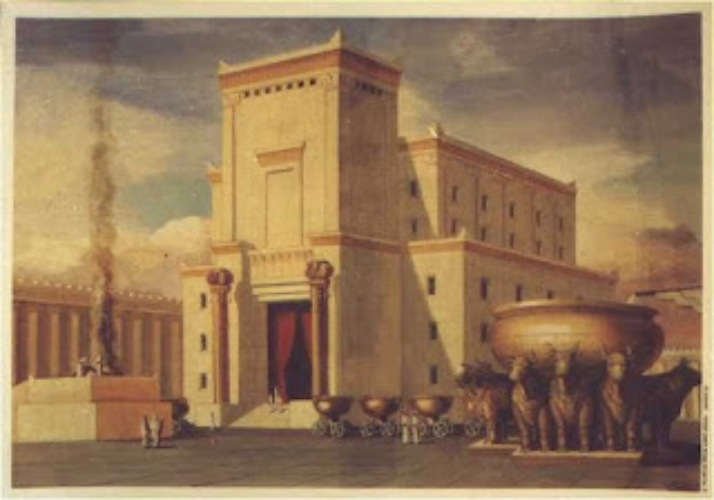
king Solomon’s temple
IMAGE LINKED: wikimedia Attribution 4.0 International (CC BY 4.0)
These Jewish sages had a special and secret interpretation of the Old Testament, and one part of this secret was to read certain significant names backwards.
If this be done in the case of the two words under consideration we find that their conjoint and full signification is.
Being fortified by the practice of every moral virtue we are now properly prepared to undergo that last and greatest trail.
The official interpretation given is not without significance as far as the first word is concerned, for God said that He would establish the House of David for ever, but while we can perceive the importance of the ancestor of King Solomon what of the Assistant High Priest?
Firstly, it must be recognised that the first column was considered to be the Royal column and the other the Priestly, and the explanation may refer to this.
In that case we obtain a declaration as to the necessity for Church and State as the foundation for civilization.
It is interesting, however, to note that those who look for a Christian interpretation of our rituals are able to point out that whole the first name refers to the founder of the House of Jesse, the other name is that of the last male ancestor of Christ, namely the husband of St. Anne and the Father of the Virgin Mary.
Thus the names of these two pillars represent the beginning and the end of the House of Jesse, from whom was drawn the body of the Saviour of Mankind.
As there is a school of symbologists who consider that the whole of the Craft degrees can be interpreted in the Christian sense, these facts cannot be ignored.
If their interpretation is correct the apparently casual reference to Hiram A’Biff, the son of a widow, takes on a new significance in association with these pillars.
In any case, in his progress through masonry this is the first mention that the candidate hears of the famous Architect. Hiram A’Biff is regarded as a prototype of the Great Master, and there does certainly seem to be a striking similarity between the chief incidents in the lives of both of them.
But this fact will become more evident when the Fellowcraft has taken his Master Masons degree.
Before leaving the subject of these two pillars it is of interest to point out that pillars are regarded as emblems of stability among many races, and on a “chop,” or certificate, used by one of the great Chinese secret societies the character KEH, meaning a pillar, is used, which among them has the further meaning of Stability.
Sir John M Cockburn recently pointed to a most pregnant fact. It is well-known that in the course of oral transmission foreign words become so corrupt in form that there comes a time when they cease to be intelligible, and in consequence attempts are made to replace them by a word whose meaning is known, and whose shape is similar to that of the corrupt word.
Many masonic students suspect that this has occurred in our ceremonies, and Sir John suggested that the Greek words lacchus and Boue [?] were the original names attached to these pillars. lacchus or Bacchus was the God of Youth and of the procreative powers.
Who in some of the Grecian Mysteries was slain and rose again, while Boue [French: trans. ‘mud’] means the primeval chaos, the dark womb of time, and so the womb.
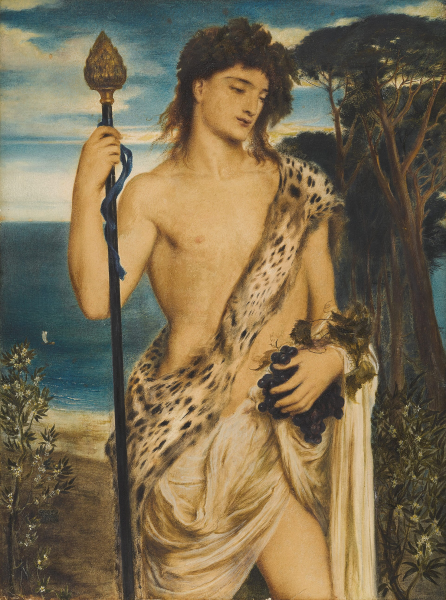
Bacchus – Simeon Solomon (1867)
IMAGE LINKED: wikimedia Attribution 4.0 International (CC BY 4.0)
This interpretation cannot be rejected lightly. Firstly, the appropriateness of such words to these two degrees is self-evident, but even more striking is the fact that the Supreme Council 33 degree of France gives to its members an esoteric interpretation of all the important words used in Freemasonry, and it interprets J****N as the phallus, and B**Z as the womb.
Spiritually interpreted this would mean that the God of Life and Light, Iacchus, descended into the womb of chaos and brought forth Life.
The tracing board having at considerable length, and in great detail, described these pillars, goes on to give a certain amount of information about the men who actually built the Temple, and a very clear distinction is drawn between the reward received for their labours by Entered Apprentices and that received by Fellowcrafts.
The Entered Apprentices, representing those who as yet are not very spiritually evolved, obtained merely simple maintenance, whereas it is specifically stated that the Fellowcrafts were paid their wages in specie, which, however, they could only receive in the Middle Chamber.
In other words, their wages were of a spiritual nature, suitable to their more evolved spirituality, and that this was so is proved by the fact that they received them in the Middle Chamber, which is an allegory for the secret chamber of the Heart, where dwells the Divine Spark.
In all mystical language, and all descriptions of mystical experience, this hidden chamber of the Heart is spoken of as the place where dwells God in man.
It is in reality a state of mystical experience, where the soul realizes, and for a brief moment of time becomes one with, the Divine Source of all.
That this is so intended is clearly indicated by the statement that when our ancient brethren. entered the Middle Chamber their attention was peculiarly directed to certain Hebrew characters, usually depicted in our Lodges by the letter G., denoting God, the G.G.O.T.U.
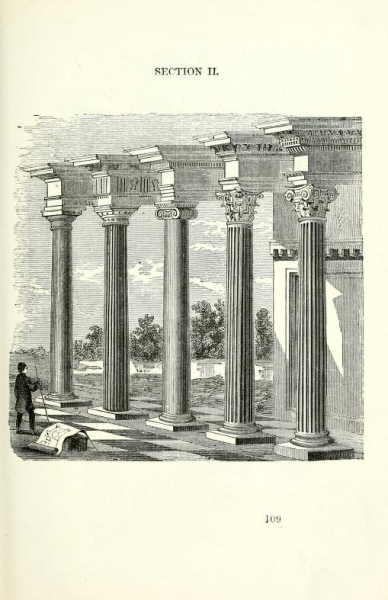
the five pillars (1867)
IMAGE LINKED: wikimedia Attribution 4.0 International (CC BY 4.0)
Now the Hebrew characters stood for Yod-He-Vau-He, or Jehovah, the G.A.O.T.U., but since, as has already been explained, each Fellowcraft in himself stands for Shin, in combination with himself he finds in the Middle Chamber the name of the Messiah, Yeheshue, (Jesus) Who is the G.G.O.T.U., or God made Flesh, Who dwells among us.
Bearing this fact in mind we shall the better understand the ceremony of closing, wherein the J.W., representing the Body, declares that in this degree they have discovered a sacred symbol, representing God.
The fact that it is the J.W. who makes this announcement, and not the S.W., is explained by the correct interpretation of the Winding Staircase.
This staircase is our own body, as we shall explain later. The ancient brethren were not permitted to ascend this staircase until they had satisfied the J.W. that they were truly Fellowcrafts, but he did not ask of them the Fellowcraft’s word as one might expect, but the password leading to that degree.
This is of course right, for he deals with the simple necessities of life, which the Entered Apprentice receives, and which to the truly spiritual man, such as the Fellowcraft claims to be, are plenty, whereas the true word, with its priestly meaning, belongs to the S.W. or Soul.
The J.W. has no part or lot in that, but it is his task to see that the Body is in good condition, for a diseased body may easily hamper the Soul in its progress.
Masonry deprecates those foolish ascetics who torture and ill-treat the body, as much as it does gross and luxurious livers, who over indulge the physical and thus hinder the soul’s advance.
The explanation of the origin of the word, although taken from the Bible, no doubt has an inner meaning. In one version we are told that Jephtha, like Joseph, and before him Ishmael, was rejected by his relations and went out from his father’s house to a strange country.
When, however, Gilead was threatened by the Ammonites and sent a deputation to him begging him to come to their help and organise armed resistance, he forgave the unkindness he had suffered and saved his native city.
Thus we can see that, like One who came after him, he was “The stone which the Builders rejected,” which became the headstone of the corner. So here again we get a reference to the Saviour of men and to Preservation.
The Winding Staircase with its three, five, seven or more steps, must have puzzled many thoughtful brethren., who have no doubt wondered why it was that those who codified our rituals could not make up their minds concerning the exact number of steps the Staircase had.
This very fact warns us that it is an allegory, for the thing disguised under this name can be considered to consist of three parts, five parts, seven parts, and possibly more.
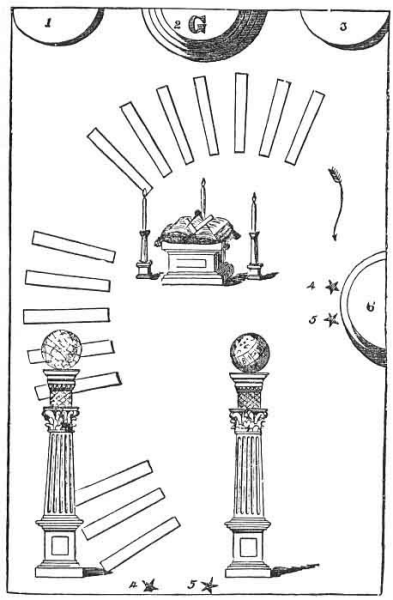
the three, five, seven steps (1867)
IMAGE LINKED: wikimedia Attribution 4.0 International (CC BY 4.0)
The three who rule a Lodge represent the Body, Soul, and Spirit which constitute Man. The five who form a Lodge are the five senses of the physical man.
But the physical man has both soul and spirit, each of which has its own peculiar sense, the Soul having psychic faculties, and the Spirit mystical and inspirational.
As the Bible indicates in the past there have been men who had second sight, and prophets who spoke by Divine inspiration.
Although while on earth the ordinary man only functions through the five physical senses, those who are approaching perfection, such as the great Masters and religious teachers of the world, function through all seven.
The reference to the five noble orders of architecture is certainly an 18th century addition, for our mediaeval brethren. cared nothing about them, while the reference to the seven liberal arts and sciences is probably a post-reference gloss.
They are good enough for an exoteric interpretation, but obviously disguise something more profound.
The five noble orders of architecture when applied to the Temple of King Solomon, are, of course, an absurd anachronism.
Perhaps at this point one should explain that the Temple at Jerusalem, masonically, is an allegory for the Temple of Humanity raised to the glory of God, or, to use a Christian simile, the Church of Christ on earth, into whose fabric every true mason is built, dedicating his body and soul as a perfect ashlar in its construction.
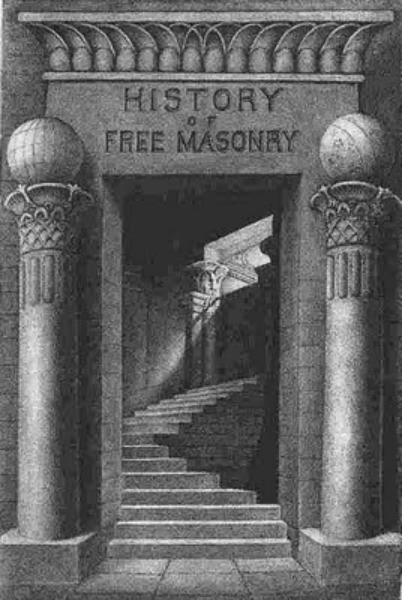
Winding Staircase
IMAGE LINKED: wikimedia Attribution 4.0 International (CC BY 4.0)
This Winding Staircase spiralled round a central column, so that when the brethren. reached the top they had advanced neither to the East nor to the West, but were still revolving around the centre.
To an Eastern Brother this Winding Staircase will certainly recall the ladder of re-incarnation, by the gradual ascent of which the Soul in time returns to God, from Whom it came, travelling upwards in a spiral.
But to the Western mind this Staircase is our own body, subdued, brought under control, and dedicated to the glory of God.
This done we receive our wages, which are knowledge of God in that hidden chamber which is within us.
No other man and no external organisation can really give us knowledge of God, that is an experience which each must discover for himself, and in himself, as every mystic has taught, no matter to what external religion he conformed.
Mysticism is not an organised religion, in rivalry with any of the established faiths, but is the real truth enshrined in every religion, and the force which gives that religion vitality.
Therefore it is that we find among Muslims, Buddhists, Jews, Hindus and Christians, men who while they often employ different symbols, use them to describe precisely the same spiritual experiences.
Finally, let us note that the last guardian who has to be passed is the Soul, which itself passes the man who is a true Fellowcraft into that hidden chamber.
When he has thus proved himself a true priest in the spiritual sense, the Soul enables him to discover the God Who is within him, and that this Divine Spark is ever linked to the Source of All.
It should be clearly understood, however, that this discovery of God within ourselves is not the end of the Mystic Quest, for the evolving Soul has other experiences to go through, some of a most painful spiritual nature, before he achieves final and complete union with the Source of his being.
But until he has had this first experience, this first realisation of the Divine Spark within him, he cannot start on the real quest; for he is not yet properly prepared.
He may, and will, come out from that secret chamber again and again, to take his part in the ordinary life of the world, but having once glimpsed the splendour of the Divine he will realise the glorious heritage to which he is the heir and will not be content until he has completed his journey.
Nevertheless, it may truly be said that these occasional experiences, brief and passing though they be, are the just reward of his labours.
This then is the great lesson of the second degree, that by ourselves, and in ourselves, we can discover and realize God, more especially in His Preservative aspect.
This discovery means more than an acquiescence in the statement of others that there is such a Being as God, it is the realisation by oneself of this stupendous fact, a thing almost impossible to describe in words except to those who have experienced it, while to them it needs no description.
[*Editor’s note: there is no reference to pillars of ‘Tatt’ and/or ‘Tattu’ in the ‘Book of the Dead’ – I wonder if he means the ‘pillars’ or ‘supports’ of Shu, god of light and air, also known as the ‘sky-bearer’ – uses four pillars/supports at the cardinal points to separate the earth from the sky. See also the myth of Geb and Nut where Shu is depicted with his arms aloft, holding the body of his daughter Nut as the sky to separate her from her brother Geb, the earth.
“…Shu, the ‘space’, the light cavity in the midst of the primordial darkness. Shu is both light and air, and as the offspring of god he is manifest life. As light he separates the earth from the sky and as air he upholds the sky vault.” -Myth and Symbol in Ancient Egypt, R. T. Rundle Clark]
Article by: J. S. M. Ward
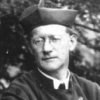
John Sebastian Marlow Ward (22 December 1885 – 1949) was an English author who published widely on the subject of Freemasonry and esotericism.
He was born in what is now Belize. In 1908 he graduated from the University of Cambridge with honours in history, following in the footsteps of his father, Herbert Ward who had also studied in history before entering the priesthood in the Anglican Church, as his father had done before him.
John Ward became a prolific and sometimes controversial writer on a wide variety of topics. He made contributions to the history of Freemasonry and other secret societies.
He was also a psychic medium or spiritualist, a prominent churchman and is still seen by some as a mystic and modern-day prophet.
Recent Articles: J.S.M Ward series

Book Review - The EA, FC, MM Handbooks
Essential reading for every Entered Apprentice, Fellowcraft, and Master Mason - these seminal books by J.S.M Ward are what every Mason needs!
more....
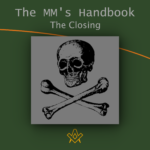 Chapters 9 & 10 The Closing Finally, even if a man can never fathom the full meaning of the third degree, yet there is no man worthy of the name who has passed through that third degree but will certainly have learnt one important lesson, namely, how to die, and thereby will be the better man. |
 Chapter 8 - The Tracing Board - The next part of the narrative is incorporated in most English workings with the Tracing Board. The most interesting feature is the description of the grave. It is obvious that peculiar stress is laid on the centre, even in the present form of our ritual, because of the way in which the measurements are given. |
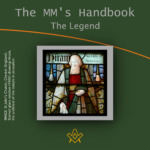 The Master Mason's Handbook P7 Chapter 7 - The Legend - After the ceremonial investiture of the Candidate the W.M. continues the narrative of the traditional history. At least this is the case in most English workings, but in some Scotch workings the whole story is told first, and subsequently the Candidate and the other brethren act the chief parts. Perhaps one of the most important points to realise is the correct meaning of the name Hiram Abiff . |
 The Master Mason's Handbook P6 Chapter 6 - The Badge - On his re-entering the Lodge, the candidate is presented and in due course invested with the badge of a Master Mason by the S.W. The Badge itself, however, is full of symbolic meaning…. |
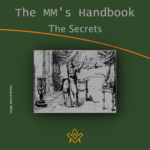 The Master Mason's Handbook P5 Chapter 5 - The Secrets. Having thus been brought into the place of light the Candidate is given not the genuine secrets, but only substituted ones. This fact must often have puzzled the Candidate. The practical reason given in the ritual, though perfectly intelligible to a Royal Arch mason (Companion) , cannot be the real one. |
 The Master Mason's Handbook P4 Chapter 4 - The Exhortation The opening part of the exhortation gives a convenient summary of the previous degrees and quite clearly indicates that the first inner meaning of the series is Birth, Life which is of course educational and preparatory for its sequel, and Death. |
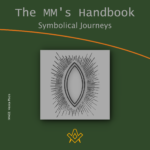 The Master Mason's Handbook P3 Chapter 3 - The Symbolical Journeys; We have seen in the previous books that the square and compasses are united on the pedestal in such a way as to form the Vesica Piscis, the emblem of the female principle, and the symbol of birth and rebirth. Hence symbolically the Candidate passes through the Vesica Piscis. |
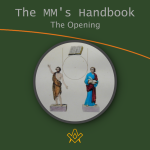 The Master Mason's Handbook P2 Chapter 2 - The Opening; a brief explanation of the teaching of the third degree as contained in the symbols by J.S.M Ward |
 The Master Mason's Handbook P1 Chapter 1 - Questions and Password; a brief explanation of the teaching of the third degree as contained in the symbols by J.S.M Ward |
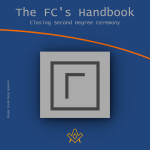 Chapter 6 - Closing Second Degree Ceremony; a brief explanation of the teaching of the second degree as contained in the symbols in the closing part of the ceremony by J.S.M Ward |
 Chapter 5 - The Second Degree Tracing Board; a brief explanation of the teaching of the second degree as contained in the picture of the tracing board according to the ancient mysteries by J.S.M Ward |
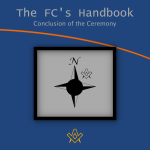 Chapter 4 - Conclusion of the Ceremony; a brief explanation of the North East Corner and the Charge according to the ancient mysteries by J.S.M Ward |
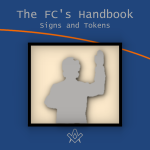 Chapter 3 - The signs and tokens; an explanation of the signs and tokens symbolism of the fellowcraft according to the ancient mysteries by J.S.M Ward |
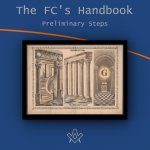 Chapter 2 - Preliminary Steps an explanation of the perambulation and advancement to the east by the winding staircase by J.S.M Ward |
 Chapter 1 - Preparation, past word and opening ceremony - The questions which are put to the candidate are really a test of the lectures, which today, unfortunately, are hardly ever given in open Lodge. |
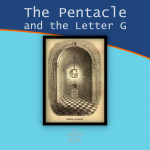 In the centre of the ceiling in every well-decorated Lodge room there should be a pentacle having within it the letter 'G'. |
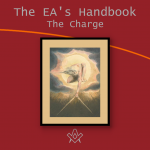 The Entered Apprentices Handbook P7 Chapter 7 - The candidate receives the charge, the first significant point is the phrase "Ancient, no doubt it is, as having subsisted from time immemorial". |
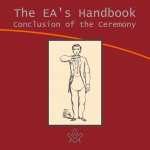 The Entered Apprentices Handbook P6 Chapter 6 - Having taken the first regular step the Candidate is given the Sign. This he is told refers to the Penalty of his Obligation, and no doubt it does, but it also seems to refer to something much more startling. |
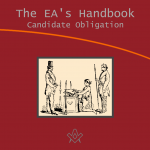 The Entered Apprentices Handbook P5 Chapter 5 - In all the ancient mysteries a candidate obligation was exacted to secure the secret teachings given in these mysteries which disclosed an inner meaning. |
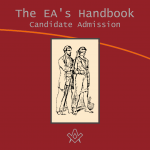 The Entered Apprentices Handbook P4 Chapter 4 - The candidate's admission into the lodge, is received on a sharp instrument. This signifies many things, one idea lying within the other. |
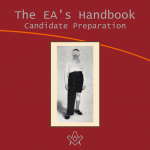 The Entered Apprentices Handbook P3 Chapter 3 - the Candidate being prepared by the Tyler. What we now have is a system by which the parts which have to be bare are made bare. |
 The Entered Apprentices Handbook P2 Chapter 2 - The Tyler or Outer Guard. The first thing that greets the eyes of the aspirant to our Order standing in front of the door with a drawn sword in his hand. |
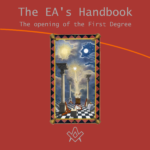 The Entered Apprentices Handbook P1 Chapter 1 - An interpretation of the first degree, the meaning of the preparation, symbolism, ritual and signs. Chapter 1, The opening of the First Degree |
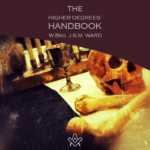 Brief historical overview; Extract from The Higher Degrees ' Handbook by JSM Ward |
masonic knowledge
to be a better citizen of the world
share the square with two brothers

click image to open email app on mobile device



